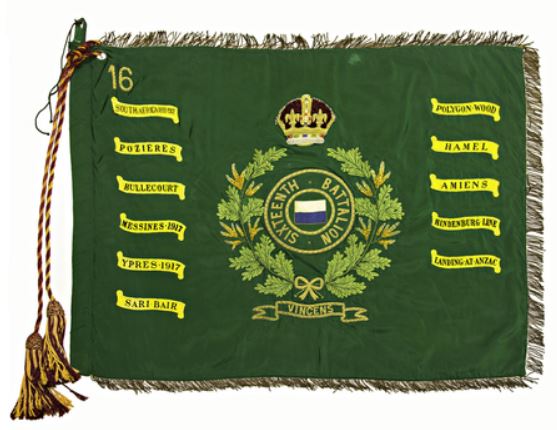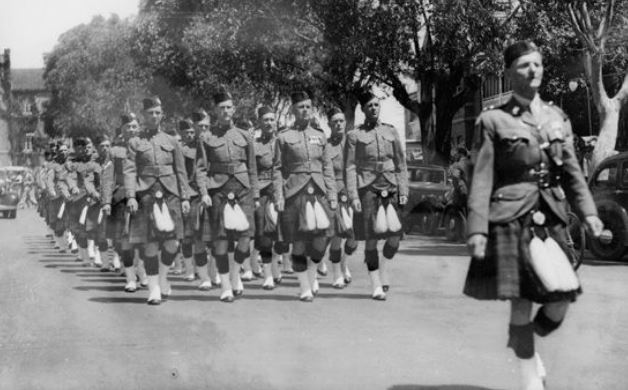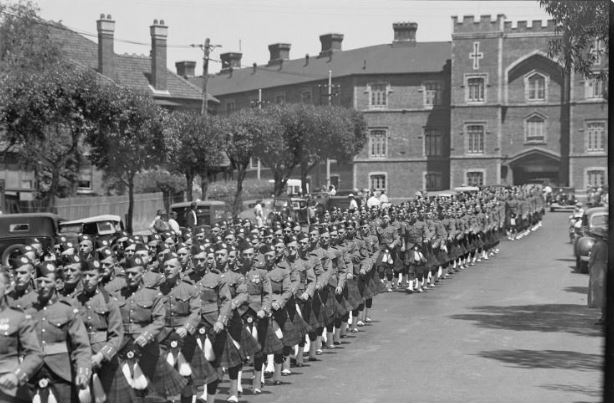16th Australian Infantry Battalion (Cameron Highlanders Regiment)
From Our Contribution
 | |
 c 1937 | |
 Marching east on St Georges Terrace - note Barracks in rear. | |
Contents
[hide]Brief History
The 16th Battalion was originally raised in September 1914. It landed at Gallipoli the following year, and also saw service in France. The battalion was disbanded at the end of the war. Following the end of WW 1, Australia's defence was conducted by the part time soldiers of the Citizens Military Force (Militia). It was re-raised as a Citizen Military Force unit, and amalgamated with the 11th Battalion in 1930. Organised to mimic the 1st AIF in structure and name, in 1936 the 16th Battalion became the Cameron Highlanders of Western Australia. Together with the 11th and 28th Battalions it formed the 13th Brigade, a part of the 4th Division and during WW 2 it was mobilised for war service , and gazetted as an AIF battalion. During the early war years, it formed part of the garrison of Western Australia, before moving north to Darwin in 1943.
In late 1944, the 13th Brigade, of which it was part, was reassigned to the 5th Division and subsequently took part in the New Britain Campaign from November 1944 until the end of the war. The campaign was limited to containing the larger Japanese force, and the battalion's involvement was focused primarily around undertaking long range patrols. They did not carry out a major offensive against the Japanese, seeking instead to confine them to Rabaul and the Gazelle Peninsula. They were based in the Bulus district and patrolled the peninsula closure daily. At the end of the war the battalion, along with the rest of the 13th Brigade moved to Rabaul to supervise the Japanese prisoners before returning to Australia in January 1946. In February 1946 the battalion was disbanded at Puckapunyal. One member of the battalion was missing in action in New Britain. One member of the Australian Army Medical Corps attached to the battalion was Mentioned in Despatches, and one died from injuries received in New Britain.
Battalion Personnel
Joined prior to war commencing
- Charles Douglas Pailthorpe DFC 1937 - 1940 discharged to join RAAF
Joined in 1940
- † Leslie John (Jock) Powell DFC April 1938- November 1940 to RAAF
- Herbert Bunney 16 Feb 1940 - 8 Feb 1946
- Robert Neil Anderson 30 Apr 1940 - 2 Jan 1946
- Jack Raymond Fuller 6 Nov 1940 - 1 Jan 1946
- Maxwell Robert Joyner 21 Nov 1940 - Oct 1942
- John Milton Hand 2 Dec 1940 - 4 Jul 1945
- Colin Lindsay Ottaway DFC 16 Dec 1940 - 17 Jan 1942 - to RAAF
Joined in 1941
- Harold Stanley Jenkins 19 Feb - 15 Oct 1941
- Keith James Buckingham 6 Mar 1941 - 27 Mar 1944
- Richard Noel Craigie 6 Mar 1941 - 9 Dec 1943
- Norman Lenard (Bob) Dunnell 6 Mar - 27 Nov 1941
- Harold Frank Davy 6 Mar 1941 - 19 Dec 1943
- Cecil Sydney Fahey 6 Mar 1941 - 1 Jun 1945
- Thomas Robert Halliday 6 Mar 1941 - 15 Jan 1942
- † Vernon Harold Minchin 6 Mar 1941 - 30 Oct 1942 - to RAAF
- Charles Kenneth Neilson 6 Mar 1941 - 13 jan 1946
- Thomas Donald Neilson 6 Mar 1941 - 23 Jul 1943
- Gordon Charles Page 6 Mar 1941 - 24 Jan 1944
- Thomas Henry (Tom) Whitehouse 6 Mar - 9 Jul 1941
- † Raymond Edward Norton Butcher ?? - Apr 1941 to RAAF
- Jack David Bunney 7 Jul 1941 - 19 Nov 1943
- William George Law 17 Jul - 19 Nov 1941
- Oliver Benson Sharpe 17 Jul 1941 - 21 Nov 1944
- Arthur McVeigh 10 Sep 1941 - 23 Dec 1941
- Noel Aubrey Brown 19 Sep 1941 - 17 Apr 1944
- Mervyn Maitland 24 Sep 1941 - 22 Jan 1942
- Raymond Ernest Buckingham 24 Dec 1941 - 16 Jan 1942 - to RAAF
Joined in 1942
- Roy William Davey 24 Jul 1942 - ????
- Alfred James Gregory 31 Oct 1942 - 27 Nov 1945
- Douglas George Edgar Alexander 12 Dec 1942 - 19 Jul 1945
- Arthur Gordon Hubbard 12 Dec 1942 - 15 Apr 1943
- Barry Martin Keeley 12 - 19 Dec 1942
- Herbert Andrew Thomas Alexander 28 Dec 1942 - 19 Jul 1945
Joined in 1945
- Herbert Patrick Carter 18 Feb 1944 - 28 May 1945
Battle Honours
- Waitavolo
Individual Honours
1 x Mentioned in Despatches
Notes